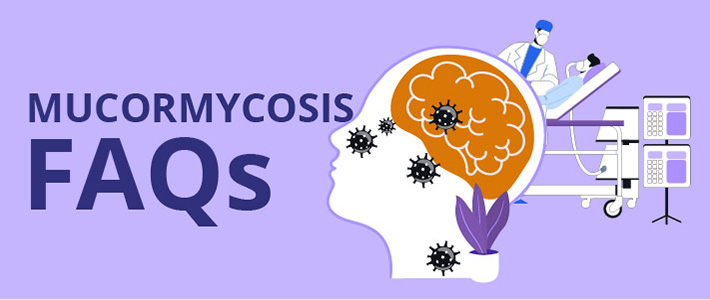Mucoromycosis (Black Fungus) FAQs

What is Mucoromycosis?
Mucoromycosis is a serious but rare fungal infection caused by a group of molds called Mucoromycetes. These molds live throughout the environment. Mucoromycosis mainly affects people who have health problems or take medicines that lower the body's ability to fight germs and sickness. It most commonly affects the sinuses or the lungs after inhaling fungal spores from the air. It can also occur on the skin after a cut, burn, or other type of skin injury.
Who is at high risk for contracting the black fungus?
Risk groups for mucoromycosis include persons with uncontrolled diabetes, cancer, transplant, persistent neutropenia (white cell counts), prolonged corticosteroid therapy, etc..
What are the possible treatment options for patients diagnosed with Mucoromycosis?
Early recognition, diagnosis, and prompt administration of appropriate antifungal treatment are important for improving outcomes for patients with Mucoromycosis. Amphotericin B, posaconazole, and isavuconazole are active against most mucoromycetes and lipid formulations of amphotericin B are often used as first-line treatment. In addition, surgical debridement or resection of infected tissue is often necessary, particularly for rhinocerebral, cutaneous, and gastrointestinal infections.
Amphotericin B is the drug of choice. It comes in 3 dose forms:
- Liposomal Amphotericin B (preferred choice)
- Amphotericin B lipid complex
- Conventional Amphotericin B (known for the highest renal toxicity)
The usual starting dose is 5 mg/kg daily of liposomal Amphotericin B and doctors sometimes increase the dose up as high as 10 mg/kg daily in an attempt to control this infection. For patients who have responded to a lipid formulation of Amphotericin B, Posaconazole or Isavuconazole can be used for oral step-down therapy. Doctors generally continue Amphotericin B until the patient has shown signs of improvement; this usually takes several weeks.
Salvage Therapy
Doctors use intravenous (IV) Posaconazole or Isavuconazole as salvage therapy for patients who do not respond to or cannot tolerate Amphotericin B. IV posaconazole is often given as a loading dose of 300 mg IV every 12 hours on the first day, followed by a maintenance dose of 300 mg every 24 hours thereafter.
The IV formulation is avoided in patients with moderate or severe renal impairment (creatinine clearance [CrCl] <50 mL/minute). In patients who are able to take medications orally, doctors use posaconazole delayed-release tablets.
Resources:
- Sabatelli F, Patel R, Mann PA, et al. In vitro activities of posaconazole, fluconazole, itraconazole, vortconazoîe, and amphotericin B against a large collection of clinically important molds and yeasts. Antimicrob Agents Chemother 2006; 50:2009.
- Diekema DJ, Messer SA, Hollis RJ, et al. Activities of caspofungin, Itraconazole, posaconazole, ravuconazole, vortconazote, and amphotericin B against 448 recent clinical isolates of filamentous fungi. J Clin Microbiol 2003; 41 :3623.
- Pfaller MA, Messer SA, Boyken t, et al. In vitro survey of triazote cross-resistance among more than 700 clinical isolates of Aspergillus species.) Clin Microbio/ 2008; 46:2568.
- Cortez KJ, Roi/Ides E, Quiroz-Telles F, et al. Infections caused by Scedosporium spp. Clin Microbio/ Rev 2008; 21:157.
- Espinel-Ingroff A, Chowdhary A, Gonzalez GM, et al. Multicenter study of isavuconazole MIC distributions and epidemiological cutoff values for Aspergíllus spp. for the CLSIM38-A2 broth microdi/ution method. Antimicrob Agents Chemother 2013; 57:3823.
- GuineaJ, Pelaez T, Recio S, et al. ln vitro antifungal activities of isavuconazole (BAL4815), voriconazole, and f/uconazole against 1,007 isolates of zygomycete, Candida, Aspergí/lus, Fusarium, and Scedosporium species. Antimicrob Agents Chemother 2008; 52: 1396.
Disclaimer, or ,Use At Your Own Risk:
Much of the information published is transcribed directly from publicly available resources.
We do not make any warranties about the completeness , reliability and accuracy of this information. Any action you take upon the information on these documents is strictly at your own risk, and we will not be liable for any losses and damages in connection with the use of our Covid-19 resources section"




